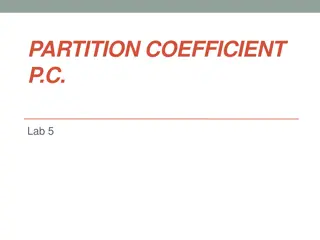Understanding Pearson Product-Moment Correlation Coefficient
Pearson product-moment correlation coefficient, denoted by "r," is a numerical measure of the strength and direction of a linear relationship between two variables. It ranges from -1 to +1, where 1 signifies a perfect positive linear correlation, -1 a perfect negative linear correlation, and 0 no correlation. This coefficient helps in analyzing the degree of association between variables and is widely used in scientific research to quantify relationships accurately.
Download Presentation

Please find below an Image/Link to download the presentation.
The content on the website is provided AS IS for your information and personal use only. It may not be sold, licensed, or shared on other websites without obtaining consent from the author. Download presentation by click this link. If you encounter any issues during the download, it is possible that the publisher has removed the file from their server.
E N D
Presentation Transcript
14 August 2024 Pearson product-moment correlation coefficient (r) LO: Calculate the Pearson product-moment correlation coefficient using the formulae and using the GDC www.mathssupport.org
Correlation. Up to this point we have used the scatter diagram to see if there is a relationship between two variables. We have stated that direction is important to determine the correlation. We have seen that the strength is important when it comes to the correlation. www.mathssupport.org
Direction Negative Correlation:- For a generally downward trend, we say that the correlation is negative. When the independent variable increases, the dependent variable decreases Positive Correlation:- For a generally upward trend, we say that the correlation is positive. An increase in the independent variable means that the dependant variable generally increases. No correlation:- For randomly scattered points, with no upward or downward trend, we say there is no correlation. No apparent link between the variables. www.mathssupport.org
Strength The strength of correlation is usually described as either strong, moderate or weak Strong positive Moderate positive Weak positive Moderate negative Weak negative Strong negative www.mathssupport.org
Correlation We have found the equation of the regression line of y on x and used the line for prediction purposes Now we are going to seek to classify the strength of the correlation numerically There are several scales in use; we will study a correlation coefficient developed by Karl Pearson The Pearson product-moment correlation coefficient denoted by r, is a measure of the correlation between two variables x and y, giving a value between -1 and +1 inclusive. It is widely used in the sciences as a measure of the strength of linear dependence between two variables www.mathssupport.org
Strength The PMCC or regression coefficient is used to determine how nearly the points fall on a straight line, or how nearly linear they are. A perfect correlation will have a regression coefficient of r = 1 If there is no correlation we will have a regression coefficient of r = 0 Perfect negative linear correlation r = -1 Perfect positive linear correlation r = 1 No correlation r = 0 www.mathssupport.org
Strength A quick way to interpret the r-value is r-value Correlation Very weak 0 |r| 0.5 0.5 |r| 0.7 0.7 |r| 0.87 Very Weak Weak Weak Moderate Strong 0.87 |r| 0.95 Very Strong Perfect 0.95 |r| 1 |r| = 1 Strong Moderate www.mathssupport.org
Calculating the Pearsons correlation coefficient (r) We use the following formulas:- ??? ???? Notes:- DON T PANIC the formulas are not that bad to use! There are other versions of these formulas that you may see in books, but the ones here are the easiest to use. x is the independent variable y is the dependent variable n is how many pairs of data you have. ? = ? ? ? ???= ?? ?2 ? ?2 ??= ?2 ? Let us see how to use them in an example ?2 ??= www.mathssupport.org
Example. number of paperback books with total number of pages, p, is recorded, as follows :- No. of pages (x): 150 200 300 350 450 Cost (y): 500 580 660 820 900 Calculate the PMCC, r, for this data and interpret the relationship. x 150 200 300 350 450 900 1450 3460 1081000 477500 2504400 The cost, c, (in pence) of a ? ? ? 1450 3460 5 ???= ?? ???= 1081000 ???= 77600 ?2 ? ?2 ??= xy x2 y2 y 14502 5 75000 116000 198000 287000 405000 22500 40000 90000 122500 202500 250000 336400 435600 672400 810000 500 580 660 820 ??= 477500 ??= 238.75 ?2 ? ?2 ??= 34602 5 ??= 2504400 ??? ???? 77600 = 0.9796 = ? = 238.75 331.78 ??= 331.78 The value 0.9796 indicates positive Very Strong correlation www.mathssupport.org
Correlation coefficient The following table is a guide for describing the strength of linear association using the correlation coefficient. Value r= 0 0 < r < 0.50 0.50 r< 0.70 0.70 r< 0.87 0.87 r< 0.95 0.95 r< 1 r= 1 Strength of association No correlation Very weak correlation Weak correlation Moderate correlation Strong correlation Very strong correlation Perfect correlation You should use your GDC to find the Correlation coefficient (r) www.mathssupport.org
Example. number of paperback books with total number of pages, p, is recorded, as follows :- No. of pages (x): 150 200 300 350 450 Cost (y): 500 580 660 820 900 Use the GDC to Calculate the PMCC, r, for this data and interpret the relationship. The cost, c, (in pence) of a Turn on the GDC Press 2 Statistics www.mathssupport.org
Example. number of paperback books with total number of pages, p, is recorded, as follows :- No. of pages (x): 150 200 300 350 450 Cost (y): 500 580 660 820 900 Use the GDC to Calculate the PMCC, r, for this data and interpret the relationship. The cost, c, (in pence) of a Turn on the GDC Press 2 Statistics Type the values of No. of pages in the list 1 Type the values of Cost in the list 2 www.mathssupport.org
Example. number of paperback books with total number of pages, p, is recorded, as follows :- No. of pages (x): 150 200 300 350 450 Cost (y): 500 580 660 820 900 Use the GDC to Calculate the PMCC, r, for this data and interpret the relationship. The cost, c, (in pence) of a Turn on the GDC Press 2 Statistics Type the values of No. of pages in the list 1 Type the values of Cost in the list 2 F2 CALC www.mathssupport.org
Example. number of paperback books with total number of pages, p, is recorded, as follows :- No. of pages (x): 150 200 300 350 450 Cost (y): 500 580 660 820 900 Use the GDC to Calculate the PMCC, r, for this data and interpret the relationship. The cost, c, (in pence) of a Turn on the GDC Press 2 Statistics Type the values of No. of pages in the list 1 Type the values of Cost in the list 2 F2 CALC F3 REG www.mathssupport.org
Example. number of paperback books with total number of pages, p, is recorded, as follows :- No. of pages (x): 150 200 300 350 450 Cost (y): 500 580 660 820 900 Use the GDC to Calculate the PMCC, r, for this data and interpret the relationship. The cost, c, (in pence) of a Turn on the GDC Press 2 Statistics Type the values of No. of pages in the list 1 Type the values of Cost in the list 2 F2 CALC F3 REG F1 X www.mathssupport.org
Example. number of paperback books with total number of pages, p, is recorded, as follows :- No. of pages (x): 150 200 300 350 450 Cost (y): 500 580 660 820 900 Use the GDC to Calculate the PMCC, r, for this data and interpret the relationship. The cost, c, (in pence) of a Turn on the GDC Press 2 Statistics Type the values of No. of pages in the list 1 Type the values of Cost in the list 2 F2 CALC F3 REG F1 X ax + b F1 www.mathssupport.org
Example. number of paperback books with total number of pages, p, is recorded, as follows :- No. of pages (x): 150 200 300 350 450 Cost (y): 500 580 660 820 900 Use the GDC to Calculate the PMCC, r, for this data and interpret the relationship. The cost, c, (in pence) of a Turn on the GDC Press 2 Statistics Type the values of No. of pages in the list 1 Type the values of Cost in the list 2 F2 CALC F3 REG F1 X ax + b F1 r = 0.97964806 The value 0.9796 indicates positive Very Strong correlation www.mathssupport.org
Thank you for using resources from A close up of a cage Description automatically generated For more resources visit our website https://www.mathssupport.org If you have a special request, drop us an email info@mathssupport.org www.mathssupport.org























